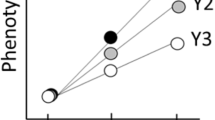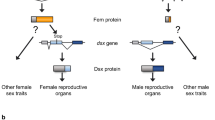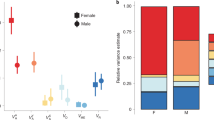Abstract
In some species, females choose mates possessing ornaments that predict offspring survival1,2,3,4,5. However, sexual selection by female preference for male genetic quality6,7,8 remains controversial because conventional genetic mechanisms maintain insufficient variation in male quality to account for costly preference and ornament evolution9,10. Here we show that females prefer ornaments that indicate genetic quality generated by transmission conflict between the sex chromosomes. By comparing sex-ratio distributions in stalk-eyed fly (Cyrtodiopsis) progeny we found that female-biased sex ratios occur in species exhibiting eye-stalk sexual dimorphism11,12 and female preferences for long eye span13,14. Female-biased sex ratios result from meiotic drive15, the preferential transmission of a ‘selfish’ X-chromosome. Artificial selection for 22 generations on male eye-stalk length in sexually dimorphic C. dalmanni produced longer eye-stalks and male-biased progeny sex ratios in replicate lines. Because male-biased progeny sex ratios occur when a drive-resistant Y chromosome pairs with a driving X chromosome15, long eye span is genetically linked to meiotic drive suppression. Male eye span therefore signals genetic quality by influencing the reproductive value of offspring16.
This is a preview of subscription content, access via your institution
Access options
Subscribe to this journal
Receive 51 print issues and online access
$199.00 per year
only $3.90 per issue
Buy this article
- Purchase on Springer Link
- Instant access to full article PDF
Prices may be subject to local taxes which are calculated during checkout




Similar content being viewed by others
References
Norris, K. Heritable variation in a plumage indicator of viability in male great tits, Parus major. Nature 362, 537–539 (1993).
Møller, A. P. Male ornament size as a reliable cue to enhanced offspring viability in the bar swallow. Proc. Natl Acad. Sci. USA 91, 6929–6932 (1994).
Petrie, M. Improved growth and survival of offspring of peacocks with more elaborate trains. Nature 371, 598–599 (1994).
Hassellquist, D., Bensch, S. & von Schantz, T. Correlation between male song repertoire, extra-pair paternity and offspring survival in the great reed warbler. Nature 381, 229–232 (1996).
Sheldon, B. C., Merilä, J., Qvarnström, A., Gustafsson, L. & Ellegren, H. Paternal genetic contribution to offspring condition predicted by size of male secondary sexual character. Proc. R. Soc. Lond. B 264, 297–302 (1997).
Pomiankowski, A. The evolution of female mate preferences for male genetic quality. Oxf. Surv. Evol. Biol. 5, 136–184 (1988).
Heywood, J. S. Sexual selection by the handicap mechanism. Evolution 43, 1387–1397 (1989).
Iwasa, Y., Pomiankowski, A. & Nee, S. The evolution of costly mate preferences. II. The “handicap” principle. Evolution 45, 1431–1442 (1991).
Burt, A. Perspective: the evolution of fitness. Evolution 49, 1–8 (1995).
Kirkpatrick, M. & Barton, N. H. The strength of indirect selection on female mating preferences. Proc. Natl Acad. Sci. USA 94, 1282–1286 (1997).
Burkhardt, D. & de la Motte, I. Selective pressures, variability, and sexual dimorphism in stalk-eyed flies (Diopsidae). Naturwissenschaften 72, 204–206 (1985).
Wilkinson, G. S. & Dodson, G. Function and evolution of antlers and eyestalks in flies.in The Evolution of Mating Systems in Insects and Arachnids(eds Choe, J. & Crespi, B.) (Cambridge Univ. Press, (1997)).
Burkhardt, D. & de la Motte, I. Big ‘antlers’ are favoured: female choice in stalk-eyed flies (Diptera, Insecta), field collected harems and laboratory experiments. J. Comp. Physiol. A 162, 649–652 (1988).
Wilkinson, G. S. & Reillo, P. R. Female preference response to artificial selection on an exaggerated male trait in a stalk-eyed fly. Proc. R. Soc. Lond. B 255, 1–6 (1994).
Presgraves, D. C., Severence, E. & Wilkinson, G. S. Sex chromosome meiotic drive in stalk-eyed flies. Genetics 147, 1169–1180 (1997).
Fisher, R. A. The Genetical Theory of Natural Selection (Dover, New York, (1958)).
Burkhardt, D. & de la Motte, I. How stalk-eyed flies eye stalk-eyed flies: observations and measurements of the eyes of Cyrtodiopsis whitei (Diopsidae, Diptera). J. Comp. Physiol. 151, 407–421 (1983).
Burkhardt, D., de la Motte, I. & Lunau, K. Signalling fitness: larger males sire more offspring. Studies of the stalk-eyed fly Cyrtodiopsis whitei (Diopsidae, Diptera). J. Comp. Physiol. A 174, 61–64 (1994).
Wilkinson, G. S. Artificial sexual selection alters allometry in the stalk-eyed fly Cyrtodiopsis dalmanni (Diptera: Diopsidae). Genet. Res. 62, 213–222 (1993).
Lenington, S. The t complex: a story of genes, behavior, and populations. Adv. Study Behav. 20, 51–86 (1991).
Wu, C.-I. The fate of autosomal modifiers of the sex-ratio trait in Drosophila and other Sex linked meiotic drive systems. Theor. Popul. Biol. 24, 107–120 (1983).
Carvalho, A. B., Vaz, S. C. & Klaczko, L. B. Polymorphism for Y-linked suppressors of sex-ratio in two natural populations of Drosophila mediopunctata. Genetics 146, 891–902 (1997).
Montchamp-Moreau, C., Cazemajor, M. & Landré, C. The sex ratio trait in Drosophila simulans: genetic analysis of distortion and suppression. Genetics(in the press).
Stalker, H. D. The genetic systems modifying meiotic drive in Drosophila paramelanica. Genetics 46, 177–202 (1961).
Hurst, L. & Pomiankowski, A. Causes of sex ratio bias may account for unisexual sterility in hybrids: a new explanation of Haldane's rule and related phenomenon. Genetics 128, 841–858 (1991).
Jaenike, J. Sex-ratio meiotic drive in the Drosophila quinaria group. Am. Nat. 148, 237–254 (1996).
Farr, J. A. Biased sex ratios in laboratory strains of guppies, Poecilia reticulata. Heredity 47, 237–248 (1981).
Houde, A. E. Mate choice based upon naturally occurring color-pattern variation in a guppy population. Evolution 41, 1–10 (1987).
Houde, A. E. Sex-linked heritability of a sexually-selected character in a natural population of guppies, Poecilia reticulata (Pisces: Poecilidae). Heredity 69, 229–235 (1992).
Hurst, L. D. Further evidence consistent with Stellate's involvement in meiotic drive. Genetics 142, 641–643 (1996).
Acknowledgements
We thank H. S. Yong, P. Reillo and M. Taper for assistance in the field; S. Bhatt, P.Reillo and D. Reames for assistance in the laboratory; and C. Boake, R. Gibson, L. Hurst, M. Kirkpatrick, R. Trivers and L. Wolfenbarger for comments on the manuscript. This work was supported by the NSF.
Author information
Authors and Affiliations
Corresponding author
Rights and permissions
About this article
Cite this article
Wilkinson, G., Presgraves, D. & Crymes, L. Male eye span in stalk-eyed flies indicates genetic quality by meiotic drive suppression. Nature 391, 276–279 (1998). https://doi.org/10.1038/34640
Received:
Accepted:
Issue Date:
DOI: https://doi.org/10.1038/34640
This article is cited by
-
Differences in energy source storage in eye stalks between two species of stalk-eyed flies, Sphyracephala detrahens and Cyrtodiopsis dalmanni
Scientific Reports (2022)
-
The fate of a suppressed X-linked meiotic driver: experimental evolution in Drosophila simulans
Chromosome Research (2022)
-
Handicap theory is applied to females but not males in relation to mate choice in the stalk-eyed fly Sphyracephala detrahens
Scientific Reports (2020)
-
Ejaculate sperm number compensation in stalk-eyed flies carrying a selfish meiotic drive element
Heredity (2019)
-
Advancing mate choice studies in salmonids
Reviews in Fish Biology and Fisheries (2019)
Comments
By submitting a comment you agree to abide by our Terms and Community Guidelines. If you find something abusive or that does not comply with our terms or guidelines please flag it as inappropriate.



